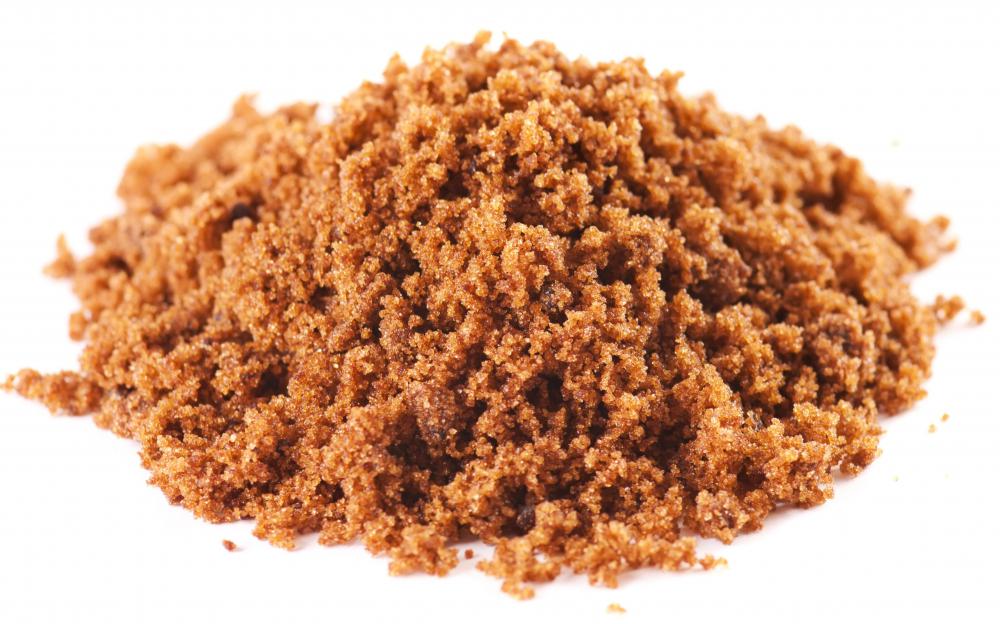At WiseGEEK, we're committed to delivering accurate, trustworthy information. Our expert-authored content is rigorously fact-checked and sourced from credible authorities. Discover how we uphold the highest standards in providing you with reliable knowledge.
What is a Brown Sugar Softener?
A brown sugar softener is a humidifying device designed to keep sugars soft. It is typically used with brown sugar, as the name implies, although a sugar softener can also be used with maple sugar. The design is intended to keep sugar moist and workable, instead of allowing it to harden into a solid mass. Kitchen specialty stores sell them, and it is also possible to make your own, if you have access to a kiln.
Typically, a brown sugar softener is made from bisqued clay. The clay is highly porous, so it absorbs and holds moisture well. The device is soaked in water for 20 minutes before being patted dry with a towel and inserted into the sugar container. Over time, the brown sugar softener slowly releases the moisture into the sugar, preventing it from drying out and hardening. After approximately three months, it will need to be re-soaked.

For cooks who struggle with lumpy brown sugar, a brown sugar softener is a highly useful tool. There are other methods of softening brown sugar, but they can get ungainly. For really hard sugar, cooks can dump it into a big bowl and cover the top with a damp cloth. Brown sugar can also be heated to loosen it up, but it needs to be carefully watched so that it does not melt or burn. If you use a softener, always remember to pat the surface water off, as straight liquid can cause the sugar to clump into a solid mass.
The basic shape for a brown sugar softener is a simple clay disk. Many companies make ornamental versions in the shapes of flowers, plants, or animals. Red clay is commonly used, since it is cheap and very porous. The clay should never be glazed, as this will make it essentially ineffective. Other pieces of unfired clay or ceramic can be used to make one as well. It should be washed when it is removed and refreshed, as sugar can become caked on it.
In addition to using a brown sugar softener, cooks should always store sugars in airtight containers to prevent them from dying out. A cool dry place is the best place to store sugar, as temperature fluctuations from heat can cause it to clump. White sugar does not generally need a softener, and will in fact clump if it is too moist.
AS FEATURED ON:
AS FEATURED ON:











Discussion Comments
@Sierra02 - I've tried that technique before with the bread slices. It was worthless to me. All I could manage to scrape off was about a teaspoon of sugar.
A clay disk is the only thing I use to soften my brown sugar with nowadays. I've even made my own before out of an old clay pot. Just break it into pieces, smooth off the edges, wash it and place it in your sugar. It works just as well as the fancy store bought ones.
My grandmother taught me how to soften brown sugar using apple slices. This works well if you know you're going to be using your sugar in the next or two because sliced apples have a short shelf life.
It's very simple to do. Just place the brick of sugar in an airtight container with a few apple slices on top. Then cover and place it in your refrigerator for a couple of days.
You can always throw out the apples and add fresh ones for longer storage time. I've also heard this same technique works well with bread slices too, but I haven't actually tried it.
There is nothing more frustrating than whipping up a batch of cookies only to find the brown sugar has turned into a brick. What I like to do soften hard brown sugar in a pinch is to put the sugar in a microwave safe bowl then cover it with a moist paper towel and microwave it for about twenty to thirty seconds.
It might still have a few chunks in it but it always softens enough sugar to work with and the little chunks usually can be pinched out rather easily. Works like a charm every time.
Post your comments